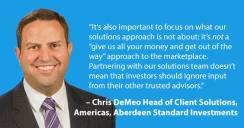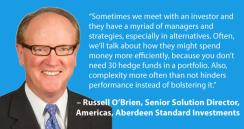Asset managers have historically been viewed as product peddlers who knew their stuff – but sellers of investment widgets, nonetheless. At Aberdeen Standard Investments (ASI), the team behind ASI Solutions has embraced a listen-first approach to determining the needs of institutional clients. From there, the team calls upon ASI’s global research teams and depth of resources to provide its clients with strategic advice and implementation, incorporating everything from macro and market insights, to strategic asset allocation, to environmental, social, and governance (ESG) concerns. But first, they listen. II recently caught up with ASI’s Chris DeMeo Head of Client Solutions, Americas, and Russell O’Brien, Senior Solution Director, Americas, for a chat about how they are working with investors today.
What were you seeing and what was happening in the market and with clients that brought about the increased focus on ASI Solutions?
Chris DeMeo: The solutions mindset is driven by the goals and needs of our clients, and the realities of the challenges they face. Whether it’s a pension fund that must make payments to retirees, an endowment or foundation with a particular spending policy, or an insurance company concerned about its reserve requirements and liquidity, they face challenges not only from the market, but also in the form of regulations, fiduciary requirements, complexity, costs, and reporting. As a $600 billion-plus asset manager that manages money in virtually every asset class and jurisdiction across the globe, we certainly feel as though we have the necessary holistic perspective. Through a combination of research, analytics, and implementation, we’re able to help asset owners meet their challenges.
How important are global capabilities to effective solutions?
Russell O’Brien: It’s becoming more common to hear from clients that they are looking for answers on a global scale and trying to find sources of help across many different outlets. You never really know what the challenge and need is until you hear it first-hand from a client. If you’re going to say you’re in the solutions business, you have to be able to solve clients’ problems holistically. With the breadth and scale of resources available at Aberdeen Standard Investments, we have that ability. For example, many clients will need a healthy allocation to private markets going forward in order to truly achieve their goals – and that’s an area of strength and expertise for our firm.
DeMeo: It’s also important to focus on what our solutions approach is not about: it’s not a “give us all your money and get out of the way” approach to the marketplace. Partnering with our solutions team doesn’t mean that investors should ignore input from their other trusted advisors. We often work collaboratively with our clients’ consultants and other asset managers so that we can develop an integrated and impactful solution to their needs.

That’s not something you hear too often in the investment world.
DeMeo: It’s hubris for any one asset manager, no matter how big, to think it can always single-handedly solve every client problem. We recognize and respect that other asset managers bring capabilities and expertise that can be complementary to achieving a client’s goals – and that’s the end purpose of what we do. Also, we have an advisory component within our organization, so we do allocate to third party managers on behalf of clients – particularly in alternatives.
O’Brien: Traditionally, an asset manager was asked to implement and execute on a specific mandate that was developed and perhaps defined by another party – typically the client’s consultant or the plan’s investment committee. In a world of increasing complexity, asset owners are relying more and more on an ecosystem that incorporates a cohesiveness between their asset managers and their consultants to help navigate their investment journey. Our Solutions Team certainly embraces this collaboration. Today, there are many instances of tripartite arrangements where, for example, the consultant might be responsible for certain aspects of the overall strategy and establishing objectives, while the manager is responsible for the overall asset allocation, implementation, and execution. It’s particularly important when managing investments for pension plans to be able to speak the same language as the consultant and understand their perspective and the plan’s liability. Our proposition incorporates the stated goal and advice into the development of a solution – but through the lens of an asset manager. We feel there are some true efficiencies and benefits to having all of these activities and decisions incorporated into one solutions-focused effort. It’s a holistic pursuit, which means we look across the whole of the client’s investment and investment-governance processes, from the initial setting of beliefs and objectives to establishing a portfolio framework, designing benchmarks, setting the asset allocation, manager selection, and implementation and reporting. It’s also about transparency and alignment of interests, which encourage a more robust communication stream.
How do solutions relationships get started?
DeMeo: Here’s an example: right now, we’re working with an endowment that has asked us to review their asset allocation in light of the recent market volatility and concerns about future market risks. Despite the equity market recovery, they are still very concerned about meeting their 2021 spending target and having enough liquidity in the coming years – especially if markets backtrack. They shared their entire portfolio with us, as well as recommendations they received from their current advisor. We came back to them with detailed recommendations highlighting solutions consistent with their goals and our macro views on the market. These included private markets more consistent with their investment time horizon, volatility mitigation strategies, and opportunistic investments including infrastructure. It’s not a recommendation to change their entire portfolio, but rather it’s focused on high-impact, high-conviction investment strategies that we believe will meaningfully improve their likelihood of achieving success. As is often the case, our recommendations were generally consistent with views from their advisor, but also included solutions where we feel we have a unique capability and experience relative to other asset managers. What we didn’t do is come to the table initially with a particular asset class in mind or any preconceived notions – we listened to their concerns, did the analytical work for them, and suggested specific solutions that fit their goals.
Every engagement with clients must be unique in many ways since it starts with listening to their specific and overall concerns and challenges.
DeMeo: That’s right. Every client has its own fingerprint. Sometimes, they’re looking for a true fiduciary solution and we can address a full portfolio solution for them, but it’s never one-size-fits-all.
O’Brien: There are many times we’ll go into a meeting and won’t have a presentation deck. It’s really about focusing on the conversation. Return is not the only driving factor of whether a pension sponsor can pay its members 30 years from now. Overly focusing on returns while ignoring risk is a recipe for disaster. The thing we believe is going to drive long-term performance is getting the right exposure to the market relative to the plan’s unique profile. It’s about enabling diversification, which includes facilitating innovation, and it’s based on effectively providing a framework that can develop new investment ideas as they come up, while also managing existing ones.

In all of the listening that you do, what are some common challenges investors are facing beyond investment strategy today?
DeMeo: Getting everyone focused on outcomes rather than returns, and that gets more to governance and defining what success looks like for a particular asset. It’s great to say, “Hey, I earned 9% last year,” but how much risk did you take to get there? What kind of liquidity risk did you take along the way? What if the next few years look very different than the past few or from what we’re all anticipating? Have you done stress tests to make sure that you can survive the journey? At the end of the day, what matters is achieving the fiduciary mission – whether that’s to pay promised retirement benefits, meet a spending goal so students can afford an education, or make sure insurance claims can be met. Investors want and need to clearly understand the risks they’re taking compared to their risk tolerance.
O’Brien: Investors today are struggling with an ever-growing mix of obligations and regulations. This also sits alongside a countless mix of investment options. Our solutions approach offers a holistic, experienced, pragmatic, and client-centric approach. It is designed to help asset owners develop interesting ways of thinking through how to blend in new asset classes, exposures, benchmarks, risks, and other portfolio management issues.
As you know, investors keep a keen eye on fees these days. What’s your value proposition in that regard?
DeMeo: Part of our mindset is to make sure that our clients are spending an impactful dollar from an outcome perspective. Are they getting a better outcome than if they didn’t spend that dollar? Could they get the same or better outcomes from spending even less? We understand the importance of that question in today’s low-yield environment. From a solutions perspective, our goal is to help clients achieve higher net risk-adjusted return including any fees we receive. So. we’re confident clients can get more value for the dollar by engaging with us.
O’Brien: Sometimes we meet with an investor and they have a myriad of managers and strategies, especially in alternatives. Often, we’ll talk about how they might spend money more efficiently, because you don’t need 30 hedge funds in a portfolio. Also, complexity more often than not hinders performance instead of bolstering it. Consequently, part of our overall discussion centers around that issue and how the client might be better served by having less complexity spread across various asset classes within the portfolio. This directly ties into fee efficiency as well.
Why does outcome lead that list of priorities?
DeMeo: If you only look at projected 10-year return and standard deviation, then you likely aren’t doing analytics to see if you will have enough money to meet your goals along the way during those 10 years. Let’s say you have inflation plus five as your investment goal – what’s the chance you’re going to fail at some point along the way? We can look at scenarios where this could happen, and make sure to align your portfolio to decrease that likelihood without materially impacting your long-term goal. Invariably, we find ways where we can improve those type of metrics and potentially provide investors true alpha. It might not be just asset allocation in a broad sense – it could be a particular strategy or allocation with correlation to an economic scenario that exacerbates drawdown risk at the worst possible time. That’s that next level of analytics that we go through to help uncover risks that clients may not have previously focused on. The industry is overly focused on statistical risk metrics like standard deviation, which are sometimes less relatable for clients. But when you translate that to say there’s a 10% chance of not being able to meet the fund’s spending policy or cash flow requirements over the next 10 years, that helps get an investor’s attention. From there, we can work with them to develop a solution that addresses this risk while still providing the long-term returns they need.
We talked about the global capabilities earlier – does that include your work as a fiduciary partner to clients?
DeMeo: It does. And again, it doesn’t necessarily mean that all clients want us to take full responsibility for the entire portfolio. Often, we work with clients in more of an ACIO [assistant CIO] capacity. But we always have a fiduciary mindset regardless of the level of delegation a client wishes us to take on for them. It’s really figuring out with the client where we can be most impactful as a fiduciary
O’Brien: Everything we do comes down to listening closely and establishing trust in a way that is more strategic than most traditional asset management relationships. There are going to be some tactical pieces of the equation that need to be addressed, but over the long term the focus is on the strategic output – the possibilities of where the client might be in the next five years, 10 years, and beyond. We’re finding that asset owners feel this type of engagement is key to accomplishing their goals.
Learn more about the good things that can happen to your portfolio when someone listens.
__________________
FOR PROFESSIONAL INVESTORS ONLY. NOT FOR USE BY RETAIL INVESTORS.
The information contained herein is intended to be of general interest only and does not constitute legal or tax advice. ASI does not warrant the accuracy, adequacy or completeness of the information and materials contained in this document and expressly disclaims liability for errors or omissions in such information and materials. ASI reserves the right to make changes and corrections to its opinions expressed in this document at any time, without notice.
The above is for informational purposes only and should not be considered as an offer or solicitation to invest in any product.
Some of the information in this document may contain projections or other forward-looking statements regarding future events or future financial performance of countries, markets or companies. These statements are only predictions and actual events or results may differ materially. The reader must make his/her own assessment of the relevance, accuracy and adequacy of the information contained in this document, and make such independent investigations as he/she may consider necessary or appropriate for the purpose of such assessment.
Any opinion or estimate contained in this document is made on a general basis and is not to be relied on by the reader as advice. Neither ASI nor any of its agents have given any consideration to nor have they made any investigation of the investment objectives, financial situation or particular need of the reader, any specific person or group of persons. Accordingly, no warranty whatsoever is given and no liability whatsoever is accepted for any loss arising whether directly or indirectly as a result of the reader, any person or group of persons acting on any information, opinion or estimate contained in this document.
In the United States, Aberdeen Standard Investments is the marketing name for the following affiliated, registered investment advisers: Aberdeen Standard Investments Inc., Aberdeen Asset Managers Ltd., Aberdeen Standard Investments Australia Ltd., Aberdeen Standard Investments (Asia) Ltd., Aberdeen Capital Management, LLC, Aberdeen Standard Investments ETFs Advisors LLC and Aberdeen Standard Alternative Funds Limited






